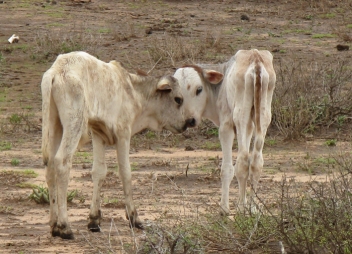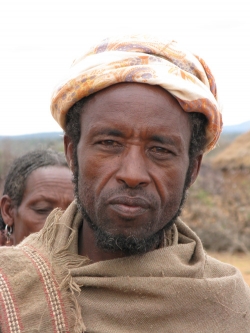 The sickly sweet stench of rotting cattle flesh overwhelmed us as we arrived in one of the kebeles (neighbourhood) in Dire woreda (district), Orimiya region, Ethiopia to check out the current drought situation.
The sickly sweet stench of rotting cattle flesh overwhelmed us as we arrived in one of the kebeles (neighbourhood) in Dire woreda (district), Orimiya region, Ethiopia to check out the current drought situation.
The horror of decaying carcasses at every turn was magnified when I caught site of a small calf, barely able to stand, bones sharply jutting out of its haunches and shoulders, nuzzling its dead mother.
Not able to suckle milk and too young to eat forage, the future of the calf looks bleak.
The cattle owner, an older pastoralist, stated flatly that it would die soon and that he and his family would be next. The despondency was etched deep across his face.
Failed rains and recurrent drought
We didn’t have to travel very far to realise that it is the same story, over and over again. This is a region beset with failed rains and recurrent drought reported to be more severe than that of 2000. Local officials claimed that this is a pattern becoming increasingly common due to changes in climate.
While all media attention is focused on the Arab uprisings, the conflict in Cote d’Ivoire or the recent US mission to put an end to Osama bin Laden in Pakistan, this region which embodies the symptoms of a wider, deeper crisis goes unnoticed and unheard.
 Death of a way of life
Death of a way of life
My colleagues from our partner organisation Action for Development (AFD) and I witnessed not only the death of cattle and newborn calves but the death of a way of life which is intrinsic to the identity of pastoralist communities in Oromiya.
Older women and men who belong to and lead these communities are now facing a day to day struggle for survival. Other regions in Ethiopia, especially Somali, and parts of northern Kenya and Somalia have not escaped the suffering either.
Our partner organisations, local district officials, community leaders and older women and men interviewed in three kebeles in Dire all confirmed that the drought situation has got worse in recent weeks. This results in an exponential increase in livestock deaths, deterioration in animal and human health, lack of food and even occasional suicides of pastoralists who can no longer support their families.
More livestock deaths anticipated
The Pastoral Development Officer in Yabello stated that the estimates of over 145, 800 livestock deaths were only the tip of the iceberg. The bitter irony is that when the long awaited rains finally began three days before our visit, they killed off weaker cattle who couldn’t move to shelter and died of exposure.
The Pastoralist Development Officer anticipates more livestock deaths in the coming weeks, wiping out even more of pastoralists’ vital but fragile asset base. On top of this, he stated that farmers have held back planting because the rains are so late.
He predicted that if the rains do not continue in sufficient quantities, farmers will not be able to plant seeds and grow their crops, adding to the burden of food insecurity in coming months. The situation is expected to get much worse through June and July before it gets better and he wanted to urge agencies and donors to act now.
Project to help pastoralists
HelpAge International has joined forces with partners in a consortium for drought mitigation and response project. The project is worth $1.4 million and will bring much needed relief and livelihood protection to 66,400 drought affected pastoralist and agro-pastoralist (a mixture of agriculture and raising livestock) households in the Moyale, Dirre, Miyo and Dillo districts of Borena Zone.
This project has been designed to provide cash transfers, supplementary emergency livestock feed, slaughter destocking services, free distribution of fresh meat and livestock hide to the most affected households, as well as cash for work to rehabilitate vital water and sanitation services.
The task ahead is immense but consortium partners hope that this initiative will go some way to addressing the acute need. They also recognise that more needs to be done and further resources are urgently required.
Read more about our emergencies work in Ethiopia
